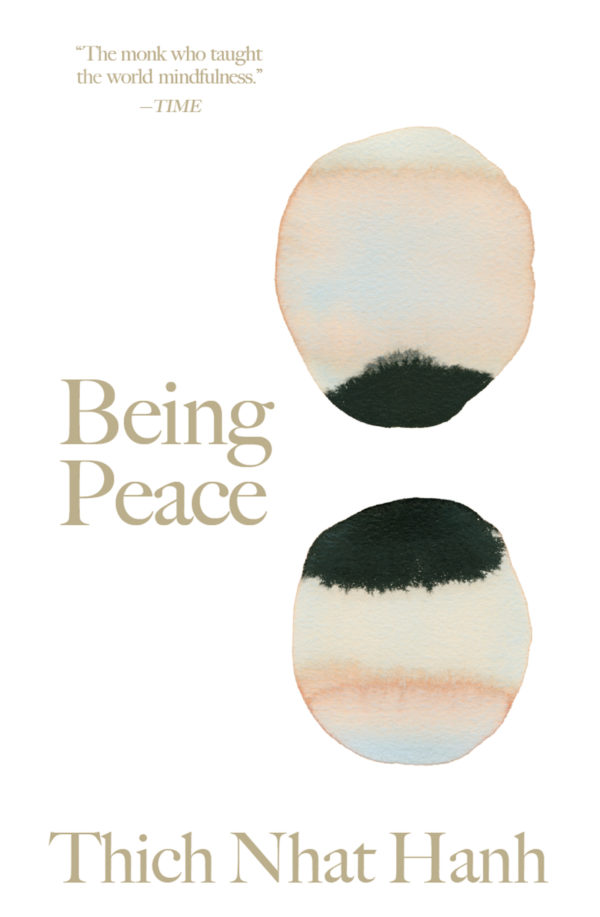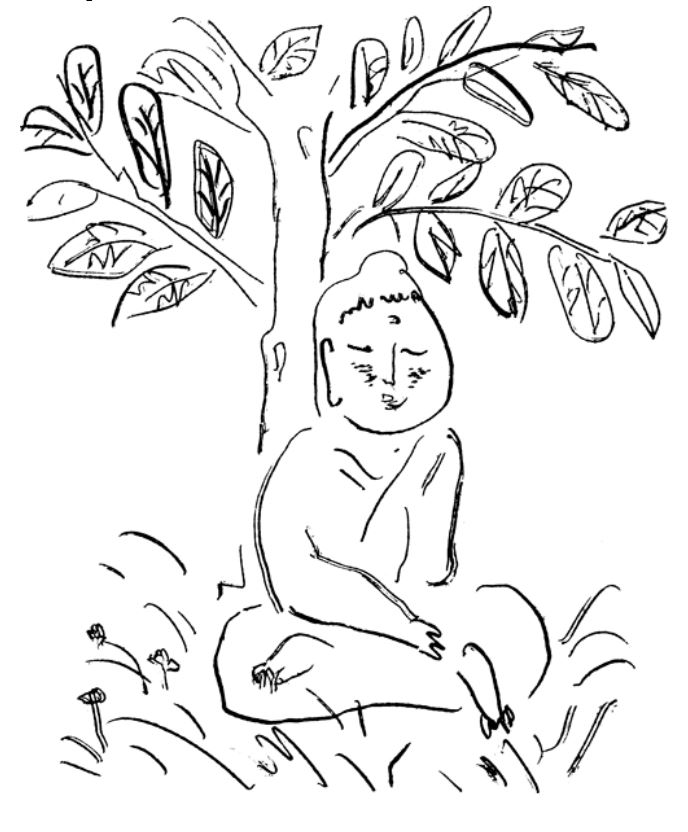
A timeless introduction to Thich Nhat Hanh’s most important teachings, this spiritual classic reveals the connection between peace in oneself and peace in the world.
Being Peace was first published in 1987 and subsequently translated into more than thirty languages. Intended for peace activists and as a commentary on the peace movement of the time, the book became a sensation, and continues to be an indispensable guide along the path.
The book’s opening has become one of Thay’s most widely quoted teachings: “Life is filled with suffering, but it is also filled with many wonders, such as the blue sky, the sunshine, the eyes of a baby. To suffer is not enough.”
The post below comprises the first part of the chapter on The Three Gems.
Many of us worry about the situation of the world. We don’t know when the bombs will explode. We feel that we are on the edge of time. As individuals, we feel helpless, despairing. The situation is so dangerous, injustice is so widespread, the danger is so close. In this kind of situation, if we panic, things will only become worse. We need to remain calm, to see clearly. Meditation is to be aware, and to try to help.
I like to use the example of a small boat crossing the Gulf of Siam. In Vietnam, there are many people, called boat people, who leave the country in small boats. Often the boats are caught in rough seas or storms, the people may panic, and boats can sink. But if even one person aboard can remain calm, lucid, knowing what to do and what not to do, he or she can help the boat survive. His or her expression—face, voice—communicates clarity and calmness, and people have trust in that person. They will listen to what he or she says. One such person can save the lives of many.
Our world is something like a small boat. Compared with the cosmos, our planet is a very small boat. We are about to panic because our situation is no better than the situation of the small boat in the sea. You know that we have more than fifty thousand nuclear weapons. Humankind has become a very dangerous species. We need people who can sit still and be able to smile, who can walk peacefully. We need people like that in order to save us. Mahayana Buddhism says that you are that person, that every one of us is that person.
I once had a student named Thich Thanh Van, who’d entered the monastery at the age of six. At the age of seventeen, he began to study with me. Later, he was the first director of the School of Youth for Social Service, where he directed thousands of young people working during the war in Vietnam, rebuilding
villages that were destroyed, and resettling tens of thousands of refugees fleeing the war zones. He was killed in an accident. I was in Copenhagen when I heard of the death of my student. He was a very gentle monk, very brave.
When he was a novice, six or seven years old, he saw people come to the temple and bring cakes and bananas to offer to the Buddha. He wanted to know how the Buddha eats bananas, so he waited until everyone went home and the shrine was closed, and then he peered through the door, waiting for the Buddha to reach out his hand, take a banana, peel it, and eat it. He waited and waited, but nothing happened. The Buddha did not seem to eat bananas, unless he realized that someone was spying on him.

Thich Thanh Van told me several other stories about when he was a young boy. When he discovered that the statue of the Buddha was not the Buddha, he began to ask where the Buddhas are, because it did not seem to him that Buddhas were living among humans. He concluded that Buddhas must not be very nice, because when people became Buddhas, they would leave us to go to a faraway country. I told him that Buddhas are us. They are made of flesh and bones, not copper or silver or gold. The Buddha statue is just a symbol of the Buddha, in the same way the American flag is a symbol of America. The American flag is not the American people.
The root word budh means to wake up, to know, to understand; someone who wakes up and understands is called a Buddha. It is as simple as that. The capacity to wake up, to understand, and to love is called Buddha nature. When Buddhists say, “I take refuge in the Buddha,” they are expressing trust in their own capacity of understanding, of becoming awake. The Chinese and the Vietnamese say, “I go back and rely on the Buddha in me.” Adding “in me” makes it very clear that you yourself are the Buddha.
In Buddhism, there are three gems: Buddha, the awakened one; Dharma, the way of understanding and loving; and Sangha, the community that lives in harmony and awareness. The three are interrelated, and at times it is hard to distinguish one from another. In everyone there is the capacity to wake up, to understand, and to love. So in ourselves we find Buddha, and we also find Dharma and Sangha. I will explain more about Dharma and Sangha, but first I want to say something about Buddha, the one who develops his or her understanding and loving to the highest degree. (In Sanskrit, understanding is prajña and love is karuna and maitri.)
Understanding and love are not two separate things, they’re just one. Suppose your son wakes up one morning and sees that it is already quite late. He decides to wake up his younger sister, to give her enough time to eat breakfast before going to school.
It happens that she is grouchy and instead of saying, “Thank you for waking me up,” she says, “Shut up! Leave me alone!” and kicks him. He will probably get angry, thinking, “I woke her up nicely. Why did she kick me?” He may want to go to the kitchen and tell you about it, or even kick her back. But then he remembers that during the night his sister coughed a lot, and he realizes that she must be sick. Maybe she has a cold, maybe that is why she behaved in such a mean way. He is not angry anymore. At that moment there is budh in him. He understands, he is awake. When you understand, you cannot help but love. You cannot get angry. To develop understanding, you have to practice looking at all living beings with the eyes of compassion. When you understand, you love. And when you love, you naturally act in a way that can relieve the suffering of people.
Someone who is awake, who knows, who understands, is called a Buddha. Buddha is in every one of us. We can become awake, understanding, and also loving. I often tell children that if their mother or father is very understanding and loving, working, taking care of the family, smiling, being lovely, like a flower, they can say, “Mommy [or Daddy], you are all Buddha today.”

Today when I woke up and went to the kitchen my husband was already there. He was sitting at the table, reading a book, I said hello, he said hello and continued to read. I felt hurt, angry, expecting a more loving response from him.
Reading this made me laugh. It opened my eyes to understand and remember that he was deeply into his book. Also because he was reading he was “somewhere else”.
When I reflected on this and understood it I was no longer angry! I felt on the edge of ashamed but understood that it was the child in me that wanted a loving hug. I can hug that child and also communicate to my husband how much I love and even need his hugs in the morning.
Thank you for this reading. 🙏
ME
Having an addiction issue along with trauma of years in prison due to it, this ‘PTSD’ makes me think: a habit is something I control, I do over and over. An addiction is also a habit but includes hurting others as well as myself.
I called in to work this morning after one year of perfect attendance: I’ll have a ‘Me Day’ and again work on myself. Because I forgot to accept the things I cannot control and those which I may be able to.
This beautiful app is what I am turning to. Beginning anew over and over if I must. I want to stop thinking of my addiction. I need to stop hurting others. I’m not at a good place right now. However… I believe I can and will make it. I will let that moment go and make new a moment everyone deserves. To feel free. Alive. Loved.
Thank you for being here for me, and others who may not say, but feel the Love.